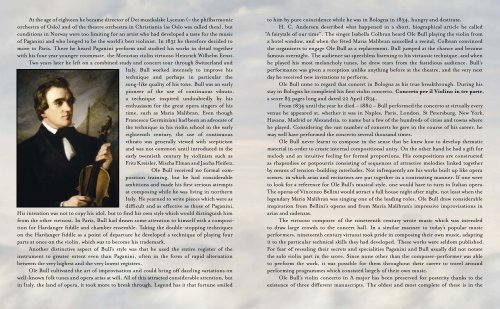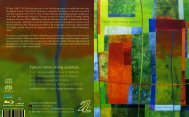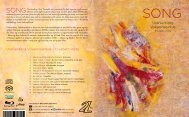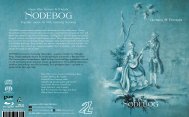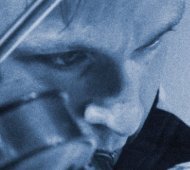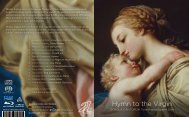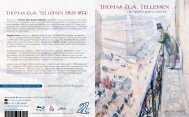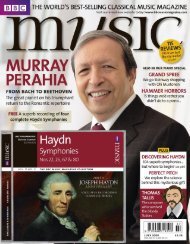*!0E1I8I-fbeice! - 2L
*!0E1I8I-fbeice! - 2L
*!0E1I8I-fbeice! - 2L
You also want an ePaper? Increase the reach of your titles
YUMPU automatically turns print PDFs into web optimized ePapers that Google loves.
At the age of eighteen he became director of Det musikalske Lyceum (= the philharmonic<br />
orchestra of Oslo) and of the theatre orchestra in Christiania (as Oslo was called then), but<br />
conditions in Norway were too limiting for an artist who had developed a taste for the music<br />
of Paganini and who longed to be the world’s best violinist. In 1831 he therefore decided to<br />
move to Paris. There he heard Paganini perform and studied his works in detail together<br />
with his four year younger roommate, the Moravian violin virtuoso Heinrich Wilhelm Ernst.<br />
Two years later he left on a combined study and concert tour through Switzerland and<br />
Italy. Bull worked intensely to improve his<br />
technique and perhaps in particular the<br />
song-like quality of his tone. Bull was an early<br />
pioneer of the use of continuous vibrato,<br />
a technique inspired undoubtedly by his<br />
enthusiasm for the great opera singers of his<br />
time, such as Maria Malibran. Even though<br />
Francesco Germiniani had been an advocate of<br />
the technique in his violin school in the early<br />
eighteenth century, the use of continuous<br />
vibrato was generally viewed with scepticism<br />
and was not common until introduced in the<br />
early twentieth century by violinists such as<br />
Fritz Kreisler, Mischa Elman and Jascha Heifetz.<br />
Ole Bull received no formal composition<br />
training, but he had considerable<br />
ambitions and made his first serious attempts<br />
at composing while he was living in northern<br />
Italy. He yearned to write pieces which were as<br />
difficult and as effective as those of Paganini.<br />
His intention was not to copy his idol, but to find his own style which would distinguish him<br />
from the other virtuosi. In Paris, Bull had drawn some attention to himself with a composition<br />
for Hardanger fiddle and chamber ensemble. Taking the double-stopping techniques<br />
on the Hardanger fiddle as a point of departure he developed a technique of playing four<br />
parts at once on the violin, which was to become his trademark.<br />
Another distinctive aspect of Bull’s style was that he used the entire register of the<br />
instrument to greater extent even than Paganini, often in the form of rapid alternation<br />
between the very highest and the very lowest registers.<br />
Ole Bull cultivated the art of improvisation and could bring off dazzling variations on<br />
well-known folk tunes and opera arias at will. All of this attracted considerable attention, but<br />
in Italy, the land of opera, it took more to break through. Legend has it that fortune smiled<br />
to him by pure coincidence while he was in Bologna in 1834, hungry and destitute.<br />
H. C. Andersen described what happened in a short, biographical article he called<br />
“A fairytale of our time”. The singer Isabella Colbran heard Ole Bull playing the violin from<br />
a hotel window, and when the fêted Maria Malibran cancelled a recital, Colbran convinced<br />
the organizers to engage Ole Bull as a replacement. Bull jumped at the chance and became<br />
famous overnight. The audience sat speechless listening to his virtuosic technique, and when<br />
he played his most melancholy tunes, he drew tears from the fastidious audience. Bull’s<br />
performance was given a reception unlike anything before at the theatre, and the very next<br />
day he received new invitations to perform.<br />
Ole Bull came to regard that concert in Bologna as his true breakthrough. During his<br />
stay in Bologna he completed his first violin concerto, Concerto per il Violino in tre parte,<br />
a score 83 pages long and dated 22 April 1834.<br />
From 1834 until the year he died – 1880 – Bull performed the concerto at virtually every<br />
venue he appeared at, whether it was in Naples, Paris, London, St Petersburg, New York,<br />
Havana, Madrid or Alexandria, to name but a few of the hundreds of cities and towns where<br />
he played. Considering the vast number of concerts he gave in the course of his career, he<br />
may well have performed the concerto several thousand times.<br />
Ole Bull never learnt to compose in the sense that he knew how to develop thematic<br />
material in order to create internal compositional unity. On the other hand he had a gift for<br />
melody and an intuitive feeling for formal proportions. His compositions are constructed<br />
as rhapsodies or potpourris consisting of sequences of attractive melodies linked together<br />
by means of tension-building interludes. Not infrequently are his works built up like opera<br />
scenes, in which arias and recitatives are put together in a contrasting manner. If one were<br />
to look for a reference for Ole Bull’s musical style, one would have to turn to Italian opera.<br />
The operas of Vincenzo Bellini would attract a full house night after night, not least when the<br />
legendary Maria Malibran was singing one of the leading roles. Ole Bull drew considerable<br />
inspiration from Bellini’s operas and from Maria Malibran’s impressive improvisations in<br />
arias and cadenzas.<br />
The virtuoso composer of the nineteenth century wrote music which was intended<br />
to draw large crowds to the concert hall. In a similar manner to today’s popular music<br />
performers, nineteenth century virtuosi took pride in composing their own music, adapting<br />
it to the particular technical skills they had developed. These works were seldom published.<br />
For fear of revealing their secrets and specialities Paganini and Bull usually did not notate<br />
the solo violin part in the score. Since none other than the composer-performer was able<br />
to perform the work, it was possible for them throughout their career to travel around<br />
performing programmes which consisted largely of their own music.<br />
Ole Bull’s violin concerto in A major has been preserved for posterity thanks to the<br />
existence of three different manuscripts. The oldest and most complete of these is in the


